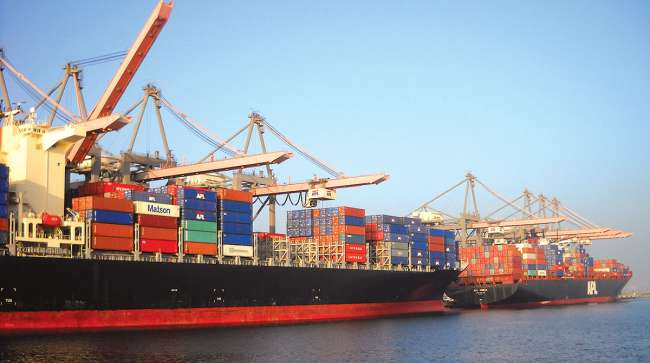Senior Reporter
Ports on Both Coasts Set Records in March

[Stay on top of transportation news: Get TTNews in your inbox.]
Container ports in March were operating at, or near, record levels on the Pacific and Atlantic coasts.
The nation’s busiest facility, the Port of Los Angeles, processed 958,674 20-foot-equivalent units — a March record. That’s up from 2021’s record 957,599 TEUs. The port also notched its best first quarter ever at 2,682,033, tracking 3.5% above last year’s record.
“With improved fluidity on our docks and fewer vessels waiting to enter the port, our terminals are processing cargo at record levels,” Port of Los Angeles Executive Director Gene Seroka said. “Yet we’re not taking anything for granted. We’re using our Port Optimizer data to find developing issues and adjust to market demands.
ICYMI: The Port of Los Angeles processed 958,674 Twenty-Foot Equivalent Units (TEUs) in March, its third consecutive monthly cargo record. The Port completed its best first quarter ever, tracking 3.5% above last year’s record. https://t.co/ucpRzgPAo9 pic.twitter.com/gNlHxkN2B6 — Port of Los Angeles (@PortofLA) April 13, 2022
The adjacent Port of Long Beach also reported a record March, processing 863,156 TEUs, a 2.7% increase over 840,387 in March 2021.
“Imports are on the rise as we continue to clear the line of ships waiting to enter our port and move containers off the docks,” Port of Long Beach Executive Director Mario Cordero stated. “Collaborating with our industry stakeholders has led to notable improvements across the supply chain.”
For the first three months of 2022, volume at Long Beach is up 3.6% to 2,460,659 year-over-year.
The March increase at Los Angeles and Long Beach came during what typically is one of the slowest months in terms of port volume.
#POLB had its busiest March and its most active quarter on record as long-dwelling cargo continued to move out of marine terminals. Dockworkers and terminal operators moved 863,156 TEUs last month, up 2.7% from the previous record set in March 2021. https://t.co/ZEpgtC6Juj pic.twitter.com/9pfN8Ep9mX — Port of Long Beach (@portoflongbeach) April 18, 2022
However, the Port of Oakland reported a 3.3% decline in container volume in March, moving 214,459 TEUs compared with 221,838 in the year-ago period.
With costs skyrocketing, some major shipping companies continue to skip Oakland. Instead, they return to Asia as quickly as possible to get more cargo to deliver to Los Angeles and Long Beach and then move the cargo north by truck. To combat that, Oakland recently announced a partnership with the U.S. Department of Agriculture to build a 25-acre “pop-up” container site to make it easier for agricultural companies to fill empty shipping containers with commodities for export.
“This creative partnership with USDA and the Port of Oakland will help American farmers and agricultural producers move their product to market while also making better use of empty containers that are causing congestion at the ports,” U.S. Transportation Secretary Pete Buttigieg said
Port officials for the Northwest Seaport Alliance (Seattle and Tacoma, Wash.) reported a 2.5% year-over-year decrease, processing 330,906 containers compared with 339,322 in 2021. Still, even with the dip in March, the combined facilities are running 0.4% ahead of last year’s first-quarter record pace, processing 901,233 containers compared with 897,325.
Container volume at @Port_Houston in March totaled 308,557 TEUs bringing the total for Q1 of 2022 to 903,383 TEUs, an increase of 20% YTD over last year’s record year. Cargo at Port Houston’s multi-purpose facility is also growing. Read more: https://t.co/26hkltxhjc pic.twitter.com/zZbwY1mZoL — Port Houston (@Port_Houston) April 18, 2022
Port Houston had a strong March, processing 14% more containers, 308,557 compared with 271,399 a year ago. Year-to-date the port is running 20% ahead of 2021’s record pace, processing 903,383 boxes versus 751,199.
To keep up with the growth, the port recently added an additional hour to the daily gate schedule and announced regular Saturday gate hours starting in June.
The Port of Savannah, Ga., reported a 10.7% year-over-year decline in March, handling 444,690 TEUs compared with 498,064. The March dip brought to an end 20 straight months of increasing volumes at the facility. Still, for the first three months of the year, Savannah is running 2.5% ahead of 2021’s record pace. The facility moved 1,381,816 containers through the end of March compared with 1,348,478 the previous year.
Port of Virginia reported a 12.6% year-over-year increase, processing 314,698 containers in March compared with 279,514 in 2021. Year-to-date the port is 9.25% ahead of last year’s record pace. As of March 31, the facility processed 872,919 TEUs versus 799,009 a year ago.
On Friday we welcomed two new Super Post-Panamax cranes to Norfolk International Terminals South. These cranes are 170 feet tall, have a boom-out length of 226 feet, and the capacity to reach across a vessel that is 26 containers wide. pic.twitter.com/Nm3v0WiVHG — The Port of Virginia (@PortofVirginia) March 28, 2022
“In terms of overall volume, this March ranks as the fourth-most productive month in our history,”
Virginia Port Authority CEO Stephen Edwards said, “We recently expanded our operating hours and are constantly adjusting the operation to ensure efficiency, access to cargo and service delivery.”
The port also took delivery of two new ship-to-shore cranes that will be operational by May, bringing to 30 capable of handling ultra-large container vessels.

Newsome
South Carolina Ports Authority reported that March’s volume also was a record, moving 264,334 containers and marking 13 consecutive record months at the Port of Charleston. March’s figure is 6.25% higher than a year ago, when 248,796 containers were processed.
Port officials said strong U.S. consumer appetite for retail goods continues to drive record cargo levels, with imports up 16% year-over-year in March.
“As we continue to handle record volumes on our terminals, SC Ports is working alongside our maritime community and logistics partners to navigate the many challenges felt across the entire supply chain,” CEO Jim Newsome said.
The Port Authority of New York and New Jersey and the Port of Baltimore did not have container numbers available at press time.
Want more news? Listen to today's daily briefing below or go here for more info:




